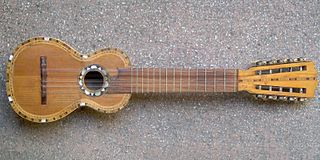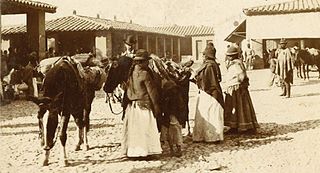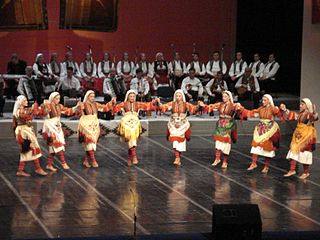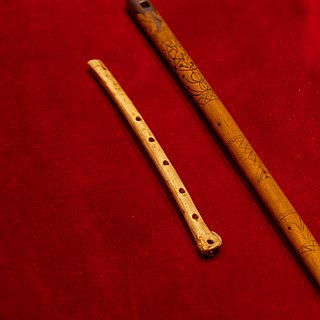
Quechua, also called Runa simi in Southern Quechua, is an indigenous language family that originated in central Peru and thereafter spread to other countries of the Andes. Derived from a common ancestral "Proto-Quechua" language, it is today the most widely spoken pre-Columbian language family of the Americas, with the number of speakers estimated at 8–10 million speakers in 2004, and just under 7 million from the most recent census data available up to 2011. Approximately 13.9% of Peruvians speak a Quechua language.

The charango is a small Andean stringed instrument of the lute family, from the Quechua and Aymara populations in the territory of the Altiplano in post-Colonial times, after European stringed instruments were introduced by the Spanish during colonialization. The instrument is widespread throughout the Andean regions of Bolivia, Peru, Ecuador, northern Chile and northwestern Argentina, where it is a popular musical instrument that exists in many variant forms.

The Aymara or Aimara, people are an indigenous people in the Andes and Altiplano regions of South America. Approximately 2.3 million Aymara live in northwest Argentina, Bolivia, Chile, and Peru. The ancestors of the Aymara lived in the region for many centuries before becoming a subject people of the Inca Empire in the late 15th or early 16th century, and later of the Spanish in the 16th century. With the Spanish American wars of independence (1810–1825), the Aymaras became subjects of the new nations of Bolivia and Peru. After the War of the Pacific (1879–1883), Chile annexed territory with the Aymara population.

Andean music is a group of styles of music from the Andes region in South America.
The music of Bolivia has a long history. Out of all the Andean countries, Bolivia remains perhaps the most culturally linked to the indigenous peoples.
Peruvian music is an amalgamation of sounds and styles drawing on Peru's Andean, Spanish, and African roots. Andean influences can perhaps be best heard in wind instruments and the shape of the melodies, while the African influences can be heard in the rhythm and percussion instruments, and European influences can be heard in the harmonies and stringed instruments. Pre-Columbian Andean music was played on drums and string instruments, like the European pipe and tabor tradition. Andean tritonic and pentatonic scales were elaborated during the colonial period into hexatonic, and in some cases, diatonic scales.

Aymara is an Aymaran language spoken by the Aymara people of the Bolivian Andes. It is one of only a handful of Native American languages with over one million speakers. Aymara, along with Spanish and Quechua, is an official language in Bolivia and Peru. It is also spoken, to a much lesser extent, by some communities in northern Chile, where it is a recognized minority language.

Hora, also known as horo and oro, is a type of circle dance traditionally performed in Southeast Europe. Circle dances called with similar names are found in Bulgaria, Greece, Moldova, North Macedonia, Romania, and culturally adopted by ethnic minorities such as the Ashkenazi Jews, Sephardic Jews and the Roma.
In recent years, Peru has revised the official spelling for place-names originating from Aymara and the Quechuan languages. A standardized alphabet for done Quechua was adopted by the Peruvian government in 1975; a revision in 1985 moved to a three-vowel orthography.

Quechua people, Quichua people or Kichwa people may refer to any of the Indigenous peoples of South America who speak the Quechua languages, which originated among the Indigenous people of Peru. Although most Quechua speakers are native to Peru, there are some significant populations in Ecuador, Bolivia, Chile, Colombia, and Argentina.

Chuño is a preserved potato product traditionally made by Quechua and Aymara communities of Bolivia and Peru, and is known in various countries of South America, including Bolivia, Peru, Chile and Northwest Argentina. It is a five-day process, obtained by exposing a bitter, frost-resistant variety of potatoes to the very low night temperatures of the Andean Altiplano, freezing them, and subsequently exposing them to the intense sunlight of the day. The word comes from Quechua ch'uñu, meaning 'frozen potato'.

South Bolivian Quechua, also known as Central Bolivian Quechua, is a dialect of Southern Quechua spoken in Bolivia and adjacent areas of Argentina, where it is also known as Colla. It is not to be confused with North Bolivian Quechua, which is spoken on the northern Andean slopes of Bolivia and is phonologically distinct from the South Bolivian variety. Estimates of the number of speakers of South Bolivian Quechua range from 2.3 to 2.8 million, making it the most spoken indigenous language in Bolivia, just slightly greater than Aymara, with roughly 2 million speakers in Bolivia. In comparison, the North Bolivian dialect has roughly 116,000 speakers.

A pinkillu, pinkuyllu or pinqullu is a flute found throughout the Andes, used primarily in Argentina northwest, Bolivia, Chile, Ecuador and Peru. It is usually played with one hand, leaving the other one free to accompany oneself on a drum like the tinya. It is used in a variety of public festivals and other kinds of communal ceremonies.

Southern Quechua, or simply Quechua, is the most widely spoken of the major regional groupings of mutually intelligible dialects within the Quechua language family, with about 6.9 million speakers. Besides Guaraní it is the only indigenous language of America with more than 5 million speakers. The term Southern Quechua refers to the Quechuan varieties spoken in regions of the Andes south of a line roughly east–west between the cities of Huancayo and Huancavelica in central Peru. It includes the Quechua varieties spoken in the regions of Ayacucho, Cusco and Puno in Peru, in much of Bolivia and parts of north-west Argentina. The most widely spoken varieties are Cusco, Ayacucho, Puno (Collao), and South Bolivian.
Kallawaya, also Callahuaya or Callawalla, is an endangered, secret, mixed language in Bolivia; another name sometimes used for the language is Pohena. It is spoken by the Kallawaya people, a group of traditional itinerant healers in the Andes in their medicinal healing practice living in Charazani, the highlands north of Lake Titicaca, and Tipuani.

The Kallawaya are an indigenous group living in the Andes of Bolivia. They live in the Bautista Saavedra Province and Muñecas Province of the La Paz Department but are best known for being an itinerant group of traditional healers that travel on foot to reach their patients. According to the UNESCO Safeguarding Project, the Kallawaya can be traced to the pre-Inca period as direct descendants of the Tiwanaku and Mollo cultures, meaning their existence has lasted approximately 1,000 years. They are known to have performed complex procedures like brain surgery alongside their continuous use of medicinal plants as early as 700 AD. Most famously, they are known to have helped to save thousands of lives during the construction of the Panama Canal, in which they used traditional plant remedies to treat the malaria epidemic. Some historical sources even cite the Kallawayas as the first to use quinine to prevent and control malaria. In 2012, there were 11,662 Kallawaya throughout Bolivia.
Dancing tradition in Serbia is represented by various styles of dances, commonly called Kolo. The word originates from the Slavic word meaning a 'wheel,' circle, or circuit. Kolo is a collective dance, where dancers hold each other's hands in either a V or W formation, making a chain or a union. It is danced by all ethnicities and religious groups both in Serbia and as well as other regions of the Balkans. Other terms such as Oro and Tanac are also used especially in regions of today's southeastern Serbia. Different forms of dances originated in different parts of Serbia, each shaped by local traditions, historical influences, and regional legacies. These dances also reflect interactions with other ethnic groups, migration patterns, changing governments, and cross regional influences.

Pachamama is a goddess revered by the indigenous peoples of the Andes. In Inca mythology she is an "Earth Mother" type goddess, and a fertility goddess who presides over planting and harvesting, embodies the mountains, and causes earthquakes. She is also an ever-present and independent deity who has her own creative power to sustain life on Earth. Her shrines are hallowed rocks, or the boles of legendary trees, and her artists envision her as an adult female bearing harvests of potatoes or coca leaves. The four cosmological Quechua principles – Water, Earth, Sun, and Moon – claim Pachamama as their prime origin. Priests sacrifice offerings of llamas, cuy, and elaborate, miniature, burned garments to her. Pachamama is the mother of Inti the sun god, and Mama Killa the moon goddess. Mama Killa is said to be the wife of Inti.

Bolivians are people identified with the country of Bolivia. This connection may be residential, legal, historical or cultural. For most Bolivians, several of these connections exist and are collectively the source of their being Bolivian.

Bigwala is a genre of ceremonial music and dance of the Busoga Kingdom in Uganda centered around gourd trumpets.














